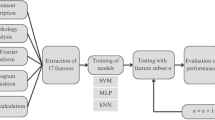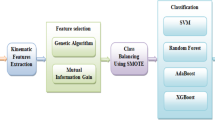Abstract
In this paper, the problem of diagnosing Parkinson’s disease based on handwritten drawings is investigated. Human-drawn spirals and meanders are used as images. A genetic fuzzy classifier is used as a diagnostic tool. This classifier is built using machine learning methods based on a discrete genetic algorithm. The multiobjective non-dominated sorting genetic algorithm was applied in the work. The diagnostic error, the number of terms, and the number of rules were used as objectives. Higher diagnostic accuracy was achieved compared to methods such as naive Bayes classifier, support vector machine and optimum-path forest. In addition, the fuzzy classifier extracts knowledge for the clinician, which makes it possible to understand causal relationships when making a diagnosis. This is achieved thanks to fuzzy rules of the IF-THEN type. These rules use the fuzzy terms “Small”, “Medium”, “Large” to evaluate the values of the features of the image.





Similar content being viewed by others
REFERENCES
I. Aouraghe, “A novel approach combining temporal and spectral features of Arabic online handwriting for Parkinson’s disease prediction,” J. Neurosci. Methods 339, 108727 (2010). https://doi.org/10.1016/j.jneumeth.2020.108727
M. Belić, V. Bobić, M. Badža, N. Šolaja, M. Đurić-Jovičić, and V. S. Kostić, “Artificial intelligence for assisting diagnostics and assessment of Parkinson’s disease—A review,” Clin. Neurol. Neurosurg. 184, 105442 (2019). https://doi.org/10.1016/j.clineuro.2019.105442
K. Deb, S. Agrawal, A. Pratap, and T. Meyarivan, “A fast and elitist multiobjective genetic algorithm: NSGA-II,” IEEE Trans. Evol. Comput. 6, 182–197. (2002). https://doi.org/10.1109/4235.996017
D. J. Gelb, E. Oliver, and S. Gilman, “Diagnostic criteria for Parkinson disease,” Arch. Neurol. 56, 33–39 (1999). https://doi.org/10.1001/archneur.56.1.33
Georgieva P., “Genetic fuzzy system for financial management,” Cybern. Inf. Technol. 18, 20–35 (2018). https://doi.org/10.2478/cait-2018-0025
H. He, Y. Bai, E. A. Garcia, and S. Li, “ADASYN: Adaptive synthetic sampling approach for imbalanced learning,” in IEEE Int. Joint Conf. on Neural Networks (IEEE World Congress on Computational Intelligence), Hong Kong, 2008 (IEEE, 2008), pp. 1322–1328. https://doi.org/10.1109/IJCNN.2008.4633969
D. Impedovo and G. Pirlo, “Dynamic handwriting analysis for the assessment of neurodegenerative diseases: a pattern recognition perspective,” IEEE Rev. Biomed. Eng. 12, 209–220. (2019). https://doi.org/10.1109/RBME.2018.2840679
D. Impedovo, G. Pirlo, G. Vessio, and M. T. Angelillo, “A handwriting-based protocol for assessing neurodegenerative dementia,” Cognit. Comput. 11, 576–586 (2019). https://doi.org/10.1007/s12559-019-09642-2
C. Kotsavasiloglou, N. Kostikis, D. Hristu-Varsakelis, and M. Arnaoutoglou, “Machine learning-based classification of simple drawing movements in Parkinson’s disease,” Biomed. Signal Process. Control 31, 174–180 (2017). https://doi.org/10.1016/j.bspc.2016.08.003
R. Lamba, T. Gulati, K. A. Al-Dhlan, and A. Jain, “A systematic approach to diagnose Parkinson’s disease through kinematic features extracted from handwritten drawings,” J. Reliab. Intell. Environ. 7, 253–262 (2011). https://doi.org/10.1007/s40860-021-00130-9
J. Mei, C. Desrosiers, and J. Frasnelli, “Machine learning for the diagnosis of Parkinson’s disease: A review of literature,” Front. Aging Neurosci. 13, 633752 (2011). https://doi.org/10.3389/fnagi.2021.633752
A. Nishihara, N. Masuyama, Y. Nojima, and H. Ishibuchi, “Michigan-Style Fuzzy Genetics-Based Machine Learning for Class Imbalance Data,” J. Jpn. Soc. Fuzzy Theory Intell. Inf. 33, 525–530 (2011). https://doi.org/10.3156/jsoft.33.1_525
Y. Omozaki, N. Masuyama, Y. Nojima, and H. Ishibuchi, “Multiobjective fuzzy genetics-based machine learning for multi-label classification,” in IEEE Int. Conf. on Fuzzy Systems (FUZZ-IEEE), Glasgow, UK, 2020 (IEEE, 2020). https://doi.org/10.1109/FUZZ48607.2020.9177804
A. Parziale, R. Senatore, A. D. Cioppa, and A. Marcelli, “Cartesian genetic programming for diagnosis of Parkinson disease through handwriting analysis: Performance vs. interpretability issues,” Artif. Intell. Med. 111, 101984 (2011). https://doi.org/10.1016/j.artmed.2020.101984
C. R. Pereira, D. R. Pereira, F. A. Silva, C. Hook, S. Weber, L. A. M. Pereira, and J. Papa, “A step towards the automated diagnosis of Parkinson’s disease: Analyzing handwriting movements,” in IEEE 28th Int. Symp. on Computer-Based Medical Systems, Sao Carlos, Brazil, 2015 (IEEE, 2015), pp. 171–176. https://doi.org/10.1109/CBMS.2015.34
C. R. Pereira, D. R. Pereira, F. A. Silva, J. Masieiro, S. Weber, C. Hook, and J. Papa, “A new computer vision-based approach to aid the diagnosis of Parkinson’s disease,” Comput. Methods Programs Biomed. 136, 79–88 (2016). https://doi.org/10.1016/j.cmpb.2016.08.005
S. Rosenblum, M. Samuel, S. Zlotnik, I. Erikh, and I. Schlesinger, “Handwriting as an objective tool for Parkinson’s disease diagnosis,” J. Neurol. 260, 2357–2361 (2013). https://doi.org/10.1007/s00415-013-6996-x
K. S. Sarin and I. A. Hodashinsky, “Bagged ensemble of fuzzy classifiers and feature selection for handwritten signature verification,” Comput. Opt. 43, 833–845 (2019). https://doi.org/10.18287/2412-6179-2019-43-5-833-845
R. Senatore and A. Marcelli, “A paradigm for emulating the early learning stage of handwriting: performance comparison between healthy controls and Parkinson’s disease patients in drawing loop shapes,” Hum. Mov. Sci. 65, 89–101 (2019). https://doi.org/10.1016/j.humov.2018.04.007
T. Y. Zhang and C. Y. Suen, “A fast parallel algorithm for thinning digital patterns,” Commun. ACM 27, 236–239 (1984). https://doi.org/10.1145/357994.358023
Funding
This research was funded by Ministry of Science and Higher Education of the Russian Federation, project number FEWM-2020–0042 (AAAA-A20–120111190016-9).
Author information
Authors and Affiliations
Corresponding authors
Ethics declarations
The authors declare that they have no conflicts of interest.
Additional information

Konstantin Sarin graduated from Tomsk State University of Control Systems and Radioelectronics (TUSUR) in 2002 with a degree in “Automated information processing and control systems”, Associate Professor of the Department for Complex Information Security of Electronic Computing Systems in TUSUR. Research interests: fuzzy systems, data analysis, machine learning, and biometrics.

Ilya Hodashinsky was born in 1953, graduated from the Faculty of Control Systems, Novosibirsk Electrotechnical Institute (NETI) in 1975. Received the Cand. Sci. degree in 1984, the D.Sc. degree in 2004 from the TUSUR, Russia. Received the Professor title at the 2011. He is a Professor of TUSUR. His main research interests include the computational intelligence, fuzzy modeling, pattern recognition, knowledge discovery, and data mining. He is author and co-author of over 150 journal and conference papers as well as technical articles. Prof. Hodashinsky is a member of IEEE, IEEE Computational Intelligence Society.

Mikhail Svetlakov graduated from TUSUR in 2019 with a degree in 10.05.04 “Information and analytical security systems”, postgraduate student of TUSUR (09.06.01 “Informatics and Computer Engineering”), Junior Researcher employee of LSAUBS (TUSUR), Lecturer at the Faculty of Security (TUSUR). Research interests: computational intelligence, metaheuristic optimization methods, deep learning methods, clustering, fuzzy systems, and biometrics.
Rights and permissions
About this article
Cite this article
Sarin, K., Hodashinsky, I. & Svetlakov, M. Extracting Knowledge from Images of Meanders and Spirals in the Diagnosis of Patients with Parkinson’s Disease. Pattern Recognit. Image Anal. 32, 658–664 (2022). https://doi.org/10.1134/S1054661822030385
Received:
Revised:
Accepted:
Published:
Issue Date:
DOI: https://doi.org/10.1134/S1054661822030385




